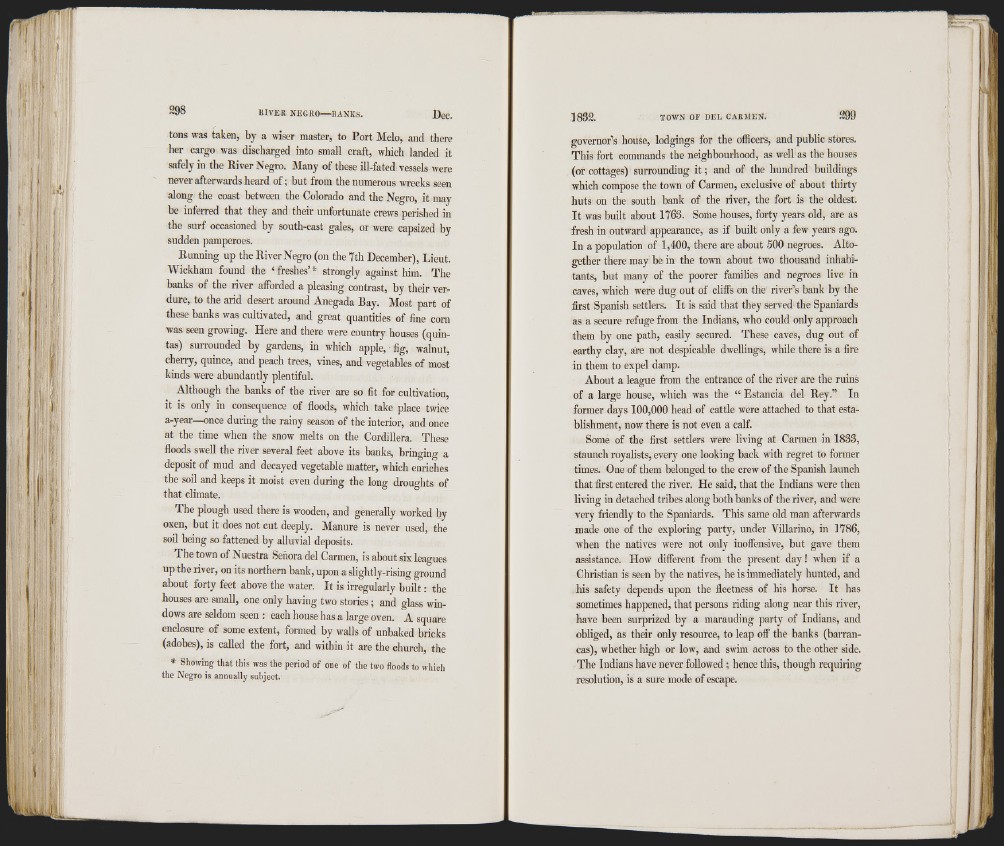
H 'í
< 'Ì ■N 4i" s V
! 'i'
, í
lili:
í Ì \ !■
tons was taken, by a wiser master, to Port Melo, and there
her cargo was discharged into small craft, which landed it
safely in the River Negro. Many of these ill-fated vessels were
never afterwards heard o f; but from the numerous wrecks seen
along the coast between the Colorado and the Negro, it may
be inferred that they and their unfortunate crews perished in
the surf occasioned by south-east gales, or were capsized by
sudden pamperoes.
Running up the River Negro (on the 7th December), Lieut.
Wickham found the ‘ freshes’* strongly against him. The
banks of the river afforded a pleasing contrast, by their verdure,
to the arid desert around Anegada Bay. Most part of
these banks was cultivated, and great quantities of fine corn
was seen growing. Here and there were country houses (quintas)
surrounded by gardens, in which apple, fig, walnut,
cherry, quince, and peach trees, vines, and vegetables of most
kinds were abundantly plentiful.
Although the banks of the river are so fit for cultivation,
it is only in consequence of floods, which take place twice
a-year—once during the rainy season of the interior, and once
at the time when the snow melts on the Cordillera. These
floods swell the river several feet above its banks, bringing a
deposit of mud and decayed vegetable matter, which enriches
the soil and keeps it moist even during the long droughts of
that climate.
The plough used there is wooden, and generally worked by
oxen, but it does not cut deeply. Manure is never used, the
soil being so fattened by alluvial deposits.
1 he town of Nuestra Señora del Carmen, is about six leagues
up the river, on its northern bank, upon a slightly-rising ground
about forty feet above the water. I t is irregularly b u ilt: the
houses are small, one only having two stories; and glass windows
are seldom seen : each house has a large oven. A square
enclosure of some extent, formed by walls of unbaked bricks
(adobes), is called the fort, and within it are the church, the
* Showing that this was the period of one of the two floods to which
the Negro is annualiy subject.
governor’s house, lodgings for the officers, and public stores.
This fort commands the neighbourhood, as well as the houses
(or cottages) surrounding it ; and of the hundred buildings
which compose the town of Carmen, exclusive of about thirty
huts on the south bank of the river, the fort is the oldest.
I t was built about 1763. Some houses, forty years old, are as
fresh in outward appearance, as if built only a few years ago.
In a population of 1,400, there are about 500 negroes. Altogether
there may he in the town about two thousand inhabitants,
but many of the poorer families and negroes live in
caves, which were dug out of cliffs on the river’s bank by the
first Spanish settlers. I t is said that they served the Spaniards
as a secure refuge from the Indians, who could only approach
them by one path, easily secured. These caves, dug out of
earthy clay, a:re not despicable dwellings, while there is a fire
in them to expel damp.
About a leaoO-ue from the entrance of the river are the ruins
of a large house, which was the “ Lstancia del Bey.” In
former days 100,000 head of cattle were attached to that establishment,
now there is not even a calf.
Some of the first settlers were living at Carmen in 1833,
staunch royalists, every one looking back with regret to former
times. One of them belonged to the crew of the Spanish launch
that first entered the river. He said, that the Indians were then
living in detached tribes along both banks of the river, and were
very friendly to the Spaniards. This same old man afterwards
made one of the exploring party, under Villarino, in 1786,
when the natives were not only inoffensive, but gave them
assistance. How different from the present day ! when if a
Christian is seen by the natives, he is immediately hunted, and
his safety depends upon the fleetness of his horse. I t has
sometimes happened, that persons riding along near this river,
have been surprized by a marauding party of Indians, and
obliged, as their only resource, to leap off' the banks (barrancas),
whether high or low, and swim across to the other side.
The Indians have never followed ; hence this, though requiring
resolution, is a sure mode of escape.